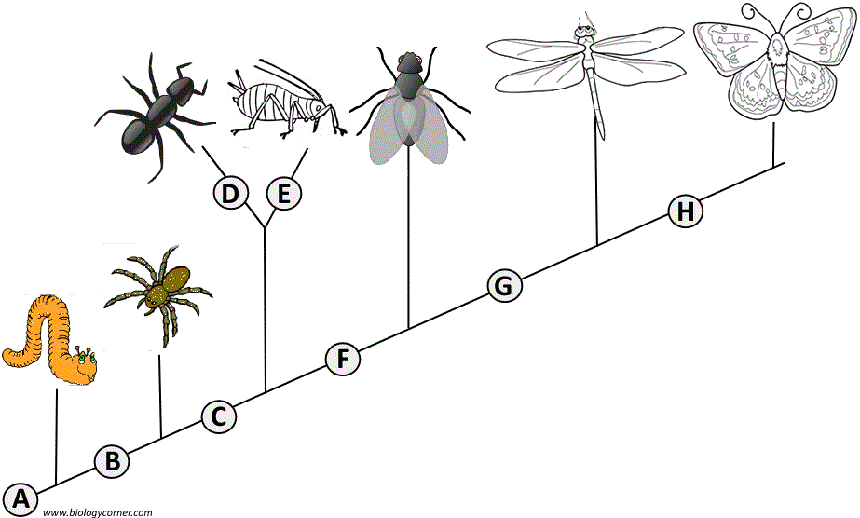The what happened to the black peppered moths during the industrial revolution and what mode of selection was this? (draw the graph)
lighter moths became preyed on because trees were dark, directional
Male Peacocks show off their colorful feathers in order to catch the female peacocks attention. This is an example of
sexual selection
What is a vestigial structure? Give an example
A structure that was inherited by ancestors however has no current purpose (tailbone, wisdom teeth, appendix, etc)
Which species does not have hair?
Everything besides primates and rabbits
Which cell is non-living, bacteria or virus?
virus they need host cell to survive
what does the x-axis and y-axis represent in the graphs of modes of selection
x-axis: traits the extremes and the normal traits
y-axis: the number in that population
A population of Madagascar hissing cockroaches lives in a woodpile. It suffers heavy predation from lizards. Because their heads are small, the lizards are unable to eat the very largest adult cockroaches, and instead prey upon small and medium sized adults. What type of selection do the lizards impose on the roaches?
natural
Give an example of a Analogous structure
bird wing-bat wing etc.
give an example of founders effect
varies
What do viruses and bacteria have in common?
they both have genetic material or DNA
A population of arboreal rodents lives in one species of pine tree. These pine trees have very evenly spaced branches of uniform thickness. Rodents that are too small cannot reach between the branches to move around in the tree. Rodents that are too big and heavy break through the branches and fall out of the trees. The rodent population contains adults of very uniform size. What mode of selection has created this uniform size distribution in these rodents? draw the graph
stabilizing
A population of arboreal rodents lives in one species of pine tree. These pine trees have very evenly spaced branches of uniform thickness. Rodents that are too small cannot reach between the branches to move around in the tree. Rodents that are too big and heavy break through the branches and fall out of the trees. The rodent population contains adults of very uniform size. What type of selection has created this uniform size distribution in these rodents?
natural
Based on the number of differences which two seem to be the most closely related
Human-Chimpanzee
Give an example of bottleneck effect
varies
how do bacteria evolve
conjugation which is sharing dan between two bacteria
A population of finches lives on an island with an abundant food supply. These finches have highly variable beak lengths, allowing them to feed on different types of food. Then several other species of birds move into the area, making food supplies scarce. The only types of food left for the finches are small seeds and nectar from long tubular flowers. Finches with small beaks can easily grasp and crack the seeds. Finches with long beaks can reach inside the long flowers to reach the nectar. However, some finches have beaks that are too large to deal with the small seeds, but too small to reach inside the flowers. After several generations, there are two populations of finches: those with short beaks and those with long beaks. What kind of selection has acted on these finches? draw graph
disruptive
What is a hybrid? give an example
crossbreed, is the result of combining two different species
Fossilized remains of prehistoric mastodons show anatomical similarities to modern-day elephants. These similarities provided the first evidence that mastodons were related to modern-day elephants.
Which of the following is the best additional evidence that mastodons were related to elephants? Pick one of the options below and justify your response.
Mastodons walked on four legs like modern-day elephants.
Mastodons ate a diet similar to that of modern-day elephants.
Mastodon fossils were found in the same area where modern-day elephants live.
Mastodon tissues contained protein sequences similar to those of modern-day elephants.
Mastodon tissues contained protein sequences similar to those of modern-day elephants.
 Which evolved last
Which evolved last
butterfly
How do viruses evolve?
they use a host cell to either incorporate their genes in their cells to replicate or they take the genes of host cells
Flowers can be red, pink, or white. Originally, the majority of the population was pink. Over time, pollinators like honey bees became even more attracted to the red flowers and after several decades of evolution, red has become vast majority color within the species. Name this mode of selection and draw a graph representing this relationship over time.
directional
What is allopatric speciation?
geographic barrier that causes a species to evolve
Is an example of what?
Homologous structures same structure developed the same way in embryos and inherited by common ancestor
Draw this cladogram
see their example
What make viruses and bacteria so good at evolution
they can divide fast and have lots of mutations which increase diversity